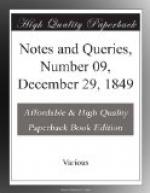G.A.C.
Sir,—In the explanation of the term Bishop Barnaby, given by J.G., the prefix “Bishop” seems yet to need elucidation. Why should it not have arisen from the insect’s garb? The full dress gown of the Oxford D.D.—scarlet with black velvet sleeves—might easily have suggested the idea of naming the little insect “Dr. Burn bug,” and the transition is easy to “Dr. Burnabee,” or “Bishop Burnaby.” These little insects, in the winter, congregate by thousands in barns for their long slumber till the reappearance of genial weather, and it is not impossible that, from this circumstance, the country people may have designated them “Barn bug,” or “Barn bee.”
L.B.L.
Sir,—I cannot inform LEGOUR why the lady-bird (the seven-spotted, Coccinella Septempunctata, is the most common) is called in some places “Bishop Barnaby.” This little insect is sometimes erroneously accused of destroying turnips and peas in its larva state; but, in truth, both in the larva and perfect state it feeds exclusively on aphides. I do not know that it visits dairies, and Tusser’s “Bishop that burneth,” may allude to something else; still there appears some popular connection of the Coccinellidae with cows as well as burning, for in the West Riding of Yorkshire they are called Cush Cow Ladies; and in the North Riding one of the children’s rhymes anent them runs:—
“Dowdy-cow, dowdy-cow, ride
away heame,
Thy[1] house is burnt, and
thy bairns are tean,
And if thou means to save
thy bairns
Take thy wings and flee away!”
The most mischievous urchins are afraid to hurt the dowdy-cow, believing if they did evil would inevitably befall them. It is tenderly placed on the palm of the hand—of a girl, if possible—and the above rhyme recited thrice, during which it usually spreads its wings, and at the last word flies away. A collection of nursery rhymes relating to insects would, I think, be useful.
W.G.M.J. BARKER.




